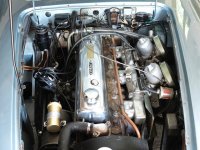My experiences are different. I've never run a fuel filter--besides the stock screens--in my BJ8 and in 120K miles never had a problem with fuel (except for a bit of vapor lock right after starting on a hot day with a hot engine, which I attribute to ethanol blended gas). No crud in either set of screens (pump and carburettors) and nothing in the float bowls. Before I sold my '96 Ranger to my dad at 110K miles I pulled the (original) fuel filter, cut it open and examined the filter media and other contents. There was only a few tiny black flakes, which I suspect were shed by the black plastic fuel tank. No dirt, sand or anything besides the black flakes, and there was just a few of them (they would be a problem in a FI engine). I have to wonder why so many Healey owners are getting so much crud in their fuel lines. Note I live in California and most, if not all service stations have had to change out their underground tanks in the last 15-20 years or so to prevent leaking into the groundwater (it put quite a few stations out of business). Maybe that's it (although I do travel throughout the western states and Canada).
Regarding the original topic--overflow--I've found the float needles have to be 'just so.' If the levers that close the needles are allowed to drop too much--the center tang on the lever at the pivot pin sets this--the needle can be jammed in its barrel. This would cause severe flooding. Also, I've had one of the rubber-tipped needles stick in its barrel, cutting off fuel to that carb completely. Grosse jets work great, if you can find two (or three) that aren't defective (the upper, small ball can stick in its opening).

 Hi Guest!
Hi Guest!

 smilie in place of the real @
smilie in place of the real @
 Pretty Please - add it to our Events forum(s) and add to the calendar! >>
Pretty Please - add it to our Events forum(s) and add to the calendar! >> 


